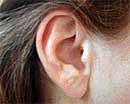How does brain hear the quietest of sounds?

When a sound is barely audible, extremely sensitive inner-ear ‘hair cells’ — neurons equipped with tiny, sensory hairs on their surface — pump up the sound by their very motion and mechanically amplify it. Richard Rabbitt of the University of Utah reported last spring on the magnification powers of the hair cells.
Now, Rabbitt and Marine Biological Lab (MBL) senior scientist Stephen Highstein have evidence that hair cells perform similarly in another context - in the vestibular system, which sends information about balance and spatial orientation to the brain.
“The bottom line is we have ‘accelerometers’ in the head that report on the direction of gravity and the motion of the head to the brain,” says Highstein. “What we found is they respond with a greater magnitude than expected for very small motions of the head. This brought to mind a similar amplification of very small signals by the human inner-ear cochlea.”
“And, in fact, the vestibular system and the cochlea have a sensory element in common: the hair cells,” Highstein adds. Rabbitt and Highstein found that, in both the auditory and the vestibular systems, the hair cell response exhibits “compressional nonlinearity.”
Deccan Herald is on WhatsApp Channels| Join now for Breaking News & Editor's Picks